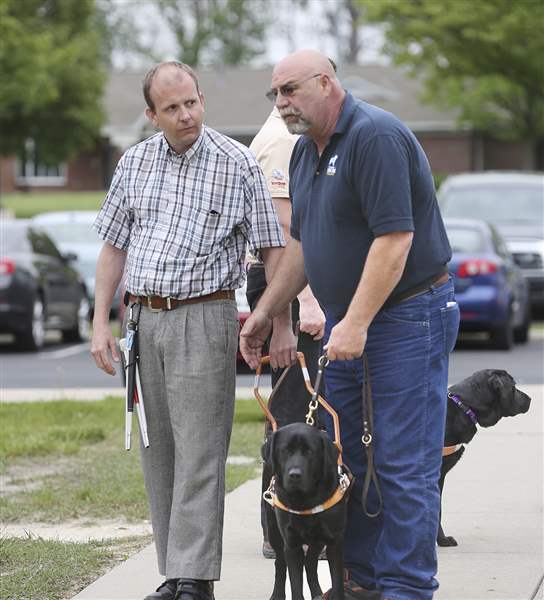
Sight-impaired get guide-dog tryouts
Workshop helps with decisions
5/20/2017
Christopher Hall, left, learns how to hold the harness of Robin, a Labrador retriever, from Greg Levick, from the Guide Dog Foundation.
THE BLADE/JETTA FRASER
Buy This Image
Walking briefly with a black Labrador retriever named Robin solidified Chris Hall’s idea into a goal.
The Findlay man craves independence, but has lost nearly all vision the last three years because of advanced glaucoma. He recently has been considering getting a guide dog to help him navigate the world.

Butts
“Before I lost my eyesight, I was very active,” he said. “Now, I can’t go anywhere, really, unless I’m with my wife. I want to be able to let go of her and walk myself.”
The Sight Center of Northwest Ohio hosted a workshop Friday with the Guide Dog Foundation, based in New York. Representatives of the foundation brought several dogs, answered a slew of questions, and let about 20 attendees experience walking with a guide dog.
“It gives them a better idea of what a dog can do, what a dog can’t do, and what’s involved in getting a dog,” Greg Levick, a field representative for the foundation, said.
Stacey Butts, executive director of the center, said staff often field questions about guide dogs. The workshop — the center’s second such event — gives people a chance to ask the experts, experience what it’s like to walk with a dog, and decide what their mobility preferences may be.
“People walk out with a pretty good feeling if it’s something they want to pursue,” she said.
Mr. Hall now walks with a cane, which he said is slow and sometimes challenging. Walking with Robin felt more natural, and he’s now decided to pursue getting a dog of his own.

Christopher Hall, left, learns how to hold the harness of Robin, a Labrador retriever, from Greg Levick, from the Guide Dog Foundation.
“It’s going to be much faster with a dog,” he said. “I can get out and do things.”
Ms. Butts said a person must first be proficient with a cane before getting a guide dog because the canine is not always going to be able to accompany its handler. A dog can get sick or injured, need a break, or just be problematic to bring along.
Brandi Shepard of Sylvania, a teacher at Southview High School, has only 8 to 20 degrees of vision in one eye. For now, she’s doing well and doesn’t use a cane, but attended the event in preparation for losing more of her vision.
After walking with one of the guide dogs at the workshop, she decided to hold off on obtaining one of her own.
“Giving up that complete control to the dog is both liberating and frightening at the same time,” she said. “At this point, having the vision I still have, I don’t think I could give up that control yet.”
Ms. Butts said guide dogs can make a person more visible, helping increase safety for someone with vision impairment.
“Someone might not notice a white cane, but everyone notices a dog,” she said.
Mr. Levick noted handlers also will have to learn how to deal with people who want to pet or otherwise interfere with their guide dogs, as well as people who don’t know the law regarding public access rights for service animals. The dogs also require daily care and ongoing training.
“There are difficulties and challenges that come with it,” Ms. Butts said. “So it’s really a preference, whatever someone is comfortable with.”
Contact Alexandra Mester: amester@theblade.com, 419-724-6066, or on Twitter @AlexMesterBlade.